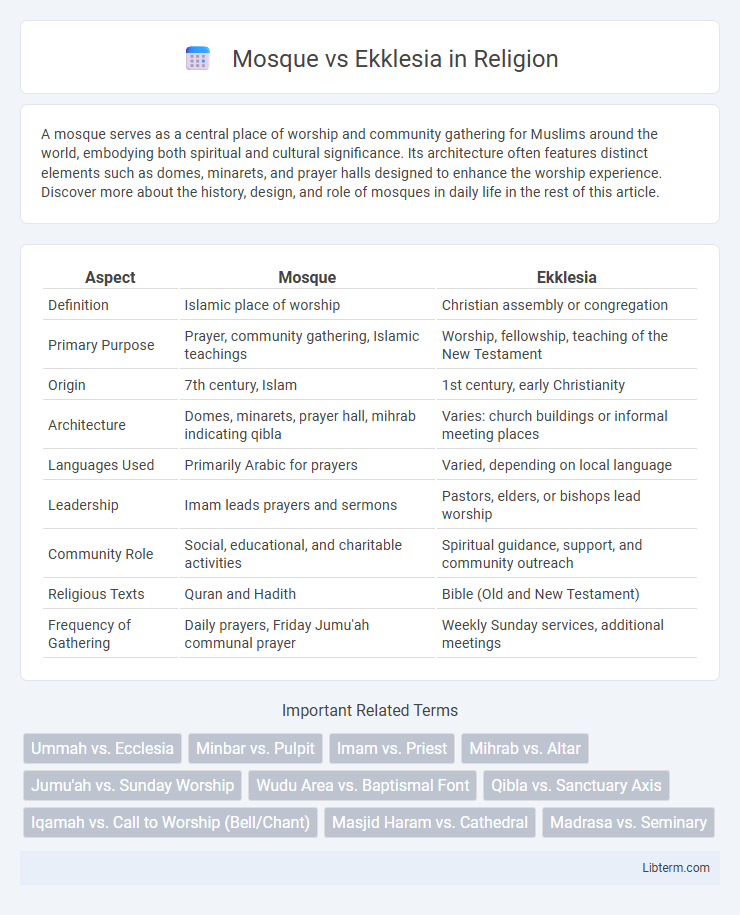A mosque serves as a central place of worship and community gathering for Muslims around the world, embodying both spiritual and cultural significance. Its architecture often features distinct elements such as domes, minarets, and prayer halls designed to enhance the worship experience. Discover more about the history, design, and role of mosques in daily life in the rest of this article.
Table of Comparison
| Aspect | Mosque | Ekklesia |
|---|---|---|
| Definition | Islamic place of worship | Christian assembly or congregation |
| Primary Purpose | Prayer, community gathering, Islamic teachings | Worship, fellowship, teaching of the New Testament |
| Origin | 7th century, Islam | 1st century, early Christianity |
| Architecture | Domes, minarets, prayer hall, mihrab indicating qibla | Varies: church buildings or informal meeting places |
| Languages Used | Primarily Arabic for prayers | Varied, depending on local language |
| Leadership | Imam leads prayers and sermons | Pastors, elders, or bishops lead worship |
| Community Role | Social, educational, and charitable activities | Spiritual guidance, support, and community outreach |
| Religious Texts | Quran and Hadith | Bible (Old and New Testament) |
| Frequency of Gathering | Daily prayers, Friday Jumu'ah communal prayer | Weekly Sunday services, additional meetings |
Introduction to Mosque and Ekklesia
A mosque is a sacred Islamic place of worship characterized by architectural elements such as domes, minarets, and prayer halls aligned towards Mecca for the five daily prayers. Ekklesia, originating from ancient Greece and adopted in early Christian contexts, refers to a gathering or assembly of believers, often functioning as a communal space for worship, teaching, and decision-making. While mosques emphasize ritual prayer and community through physical space, ekklesia highlights the collective body of faith participants and their spiritual fellowship.
Historical Origins of Mosque and Ekklesia
The mosque originated in the early 7th century as a communal place of worship in Islam, with the Prophet Muhammad's house in Medina serving as the prototype for the first mosque, the Masjid al-Nabawi. The term ekklesia, derived from ancient Greek, historically referred to the assembly of citizens in city-states like Athens and evolved into a concept of Christian congregational worship spaces during the Roman Empire. Both structures symbolize foundational religious and community gathering places, reflecting their distinct cultural and theological origins across Islamic and Christian traditions.
Etymology: Meaning Behind the Words
The term "mosque" originates from the Arabic word "masjid," meaning "place of prostration," emphasizing its function as a space for Islamic worship and submission to God. In contrast, "ekklesia" stems from the ancient Greek verb "ek-kalein," which means "to call out," referring to an assembly or gathering, particularly in the context of early Christian congregations. These etymologies reveal the mosque as a dedicated worship site and the ekklesia as a community-centric gathering, highlighting distinct cultural and religious practices.
Architectural Differences and Similarities
Mosque architecture typically features large domes, minarets, and expansive prayer halls oriented towards Mecca, emphasizing open, communal worship spaces. Ekklesia buildings, or Christian churches, often include nave-centered layouts, steeples, and cruciform floor plans, designed to facilitate liturgical rituals and congregational gatherings. Both structures prioritize acoustics and natural light to enhance spiritual experiences, yet they diverge in symbolic elements and spatial organization reflective of Islamic and Christian worship practices.
Core Functions and Purpose
Mosques primarily serve as places of worship for Muslims, facilitating daily prayers, Friday congregational prayers (Jumu'ah), and community gatherings centered around Islamic teachings. Ekklesia, in the Christian tradition, functions as both a place of worship and a community assembly, emphasizing collective worship, teaching of Scripture, sacraments such as the Eucharist, and fostering spiritual fellowship. Both institutions act as central hubs for religious education, moral guidance, and social cohesion within their respective faith communities.
Religious Practices and Rituals
Mosques serve as central places for Islamic worship, where practices like Salah (five daily prayers), Friday Jumu'ah congregational prayers, and Ramadan fasting rituals are observed. Ekklesia, referring to early Christian assemblies and modern church gatherings, centers around Eucharist celebrations, baptism rites, and communal worship through hymns and scripture readings. Both religious spaces prioritize community participation but differ in ritual expressions tied to their distinct theological foundations.
Community Roles in Islam and Christianity
Mosques serve as central hubs for Muslim communities, facilitating daily prayers, educational programs, and social gatherings that reinforce Islamic values and foster unity. Ekklesia, in Christian contexts, functions as the assembly of believers gathering for worship, teaching, and communal support, emphasizing fellowship and spiritual growth. Both institutions play pivotal roles in nurturing faith, providing moral guidance, and strengthening communal bonds within their respective religious traditions.
Symbolism in Mosque and Ekklesia Design
Mosque symbolism centers on elements like the mihrab, which indicates the qibla direction toward Mecca, and the minaret, symbolizing the call to prayer and divine presence. Ekklesia design emphasizes the cross, representing Christ's sacrifice, and the altar, signifying the Eucharist and community worship. Both architectural forms integrate symbolic features to foster spiritual connection and communal identity within Islamic and Christian worship.
Evolution Through History
The mosque and the ekklesia have evolved distinctly through history, reflecting their roles in Islamic and early Christian communities, respectively. Mosques developed from simple prayer spaces in the 7th century Arabian Peninsula into complex architectural and cultural hubs that facilitate worship, education, and social gatherings. The ekklesia, originating as early Christian assemblies often held in private homes or public places, gradually transformed into formal church buildings crucial for liturgical functions and community cohesion throughout the Roman and Byzantine eras.
Contemporary Significance and Global Impact
The mosque, as a central place of worship in Islam, fosters community cohesion and spiritual practice across diverse Muslim populations, influencing social and cultural dynamics worldwide. The ekklesia, rooted in early Christian assemblies, shapes democratic principles and collective decision-making practices in both religious and secular contexts globally. Both institutions serve as pivotal nodes for identity formation, political activism, and intercultural dialogue in contemporary societies.
Mosque Infographic

 libterm.com
libterm.com